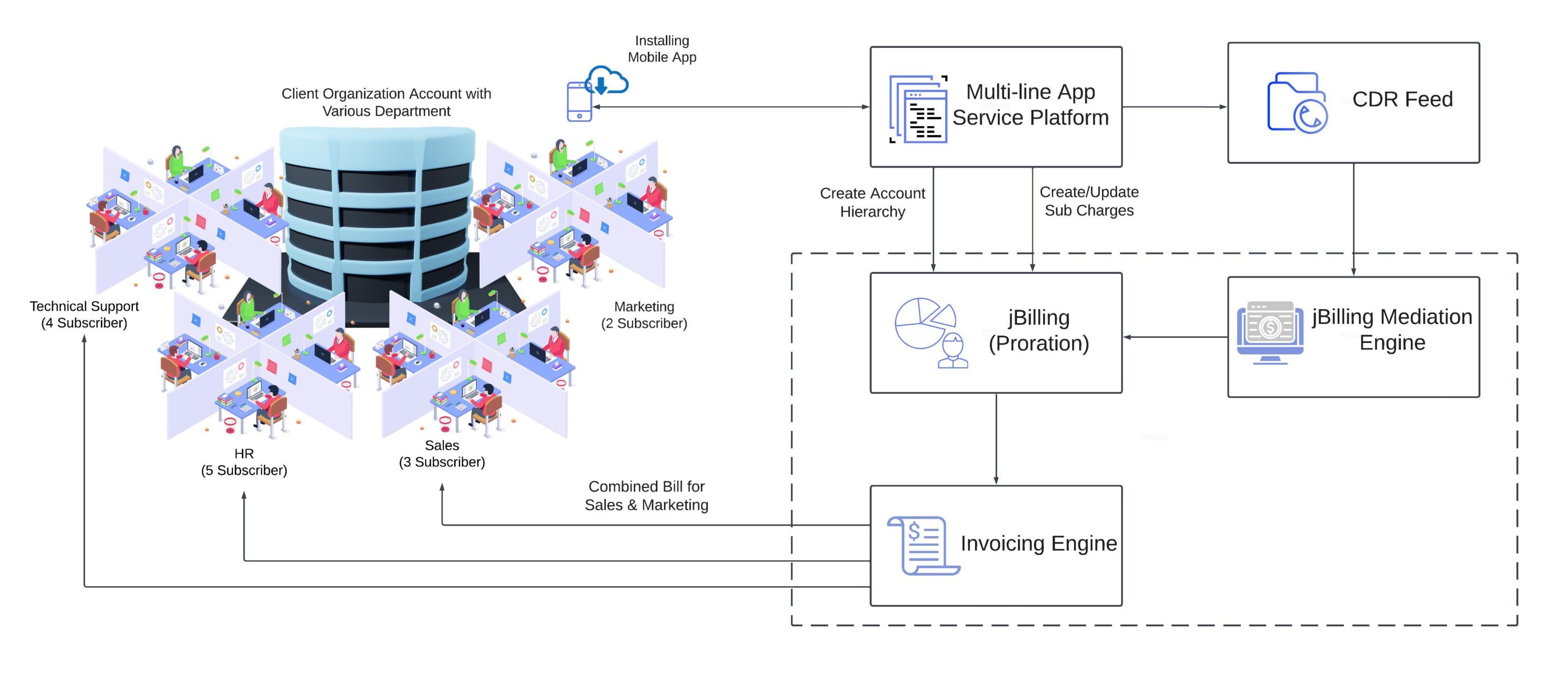Case Study – Billing and Mediation System for a MultiLine Mobile App Service
COMPANY
INDUSTRY
CHALLENGE
SOLUTIONjBilling Cloud, customized to meet the various requirements through:
RESULTS
|
ABOUT THE CLIENT
This is a case study of a US Based MultiLine mobile app service which provides a second, secure business number for voice, text, and WhatsApp conversations. This service is targeted for B2B use, offering additional mobile numbers to employees of an organisation without having to add new sims, thus avoiding personal number use for official business.
The service also avoids costs associated with purchasing of new mobile devices for the client companies.
CHALLENGE
The client has several tie ups with telecom service providers in different geographies in order to provide this “over-the-top” service (or OTT). The mobile app would depend on the underlying sim card provided by one of the mobile service providers with whom the client has the tie-up. The client would block the sims and the associated numbers with the mobile service providers. The service would not require the actual sim to be provided to the subscriber or user. Only the additional number would be provided as part of the service.
The client exclaims “We evaluated several billing and mediation rating platforms. None would provide the flexibility and extensibility we were looking for in our business. Those that seemed like meeting everything, were completely out of our budget!”
The additional number provided by this multi-line service could be used on the existing sim card of the user (which may be from a different mobile service provider). All that the user has to do is to install the client’s mobile app on the mobile and configure it. Then the user could share the additional number for business purposes and can make and receive calls using this additional number using the mobile app.
Our client adds, “We clearly needed a system which can support on-boarding new carriers with ease. We were in discussion with so many mobile companies all across the world. We needed a system that can easily accommodate termination charges from our new tie-ups.”
Various companies (basically the clients) bulk buy such additional numbers as part of contracts with our client. They would share these numbers with their employees for official use. Each employee using such additional number configures the mobile app on his or her device and starts using the new number for company’s official work.
One of the challenges with this service is to track various departments of the company, which department uses how many numbers. The additional mobile numbers would vary within the month based on addition of new employees, or employees leaving the company etc. This means that tracking of mobile numbers based on the number of days they are in use in the month is required. The subscription charges would then be pro-rated depending on the days that those mobile numbers are in use.
Our client explains – “We needed the prorating of subscription charges to ensure fair charging to our customers based on their actual usage of the service.” The Billing and Revenue Management solution needs to track addition and removal of numbers from customer subscriptions and track changes to the subscriptions and bill accordingly.
The other challenge for this business model was to maintain a multi level (up to level n) organisation hierarchy of the client organisation with clear marking of which department pays their own bill and which departments’ bills are paid by their parent company or higher department. The invoice needs to be generated based on which department has been flagged to receive the bill. Other way round, a department could receive the bill for themselves as well as for other associated child department(s).
This kind of set up needed account hierarchy feature that can go up to n-level and has flexibility to maintain sub accounts under the main company account.
The business model involved 3 types of charges, subscription, origination and termination charges. Out of these the origination charges and termination charges were applied from the telecom service providers for the actual service (such as calls, data usage, international calls etc), whereas the subscription charges are from the client side and this provides the source of revenue for the client.
To apply the termination charges (from the telecom network provider where the calls or usage is terminated) for the usage of various mobile services, the CDR files received from the mobile companies need to be processed.
The client needed the flexibility to apply the origination and termination charges as-is without any additional margin as well as introduce the margin in future if required. The rate changes needed to be handled seamlessly by the system when they are initiated.
The business also needed to cater to offerings in various countries, specifically in the US, UK and Singapore in the initial phases. This meant that the billing system chosen needed to be compliant with taxation rules in these countries.
Solution
The client chose the Enterprise jBilling platform as their billing system because of the flexibility the platform offers with billing mediation and prorating of subscription and origination charges.

As it can be seen in the solution diagram above, when a client organisation signs a contract, the organisation is on-boarded to the client platform. The client platform comprises of the mobile app (client) connected to the Multi-Line App Service hosted by the client on the Cloud. The client company users subscribe to the mobile app by downloading and installing it on their device. This app allows them to configure their second line number with the existing SIM card.
The Multi-line App Service platform is integrated to the jBilling system and it sends the account hierarchy of the client organisation to jBilling. The client company is created in jBilling, along with the subscription and origination charges. This includes the list of mobile numbers subscribed to.

The client platform is responsible for receiving the usage records or Call Data Records (CDRs) from the carriers (or various Mobile Service Providers), nurturing the call records and then feeding them to the jBilling’s billing mediation engine. The client platform also sends the updates to the subscription charges and the origination charges to the jBilling platform.
The jBilling system then applies the various prorating rules on the subscription and origination charges depending on the mobile numbers subscribed by a client organisation. The jBilling mediation engine applies rate card on the termination charges (CDRs) and generates bills to be sent to the various billable departments within the client organisation.
Subscription and Origination Charges
Applying recurring charges such as the Subscription charges and Origination charges involved creating these charges through the integration channel. The client’s systems sent these charges as the users subscribed to their various plans. The jBilling system received API calls for creating recurring subscription and origination charges. The client system also sent any updates to the number of subscriptions bought by a company in separate API calls.
Prorating
The jBilling system tracks the changes in number of subscriptions bought by a client company. For example, if an Organisation ABC has 50 live subscriptions on Jan 1 for a particular year, and they decide to buy 10 more numbers on Jan 16, then the system should be able to apply the charges for 50 numbers from Jan 1 to Jan 31, and then apply the prorated subscription charges for 10 additional numbers from Jan 16 to Jan 31.
Suppose their plan charges $5 subscription charges for each number, then the following lines would be charged for the above example:
Subscription Charges from Jan 1 to Jan 31 Qty=50 Price=$5/number/month Amount=$250.0000
Subscription Charges from Jan 16 to Jan 31 Qty=10 Price=$5/number/month Amount=$25.8064
Total Amount Charged = $275.8064
The prorated calculations from Jan 16 to Jan 31 are as follows: The Prorated Amount for 16 days, Qty 10 and Price=$5/number/month = 16/31 * $5 * 10 = $25.8064.
Continuing the above example, if the Company ABC reduced 5 numbers on Feb 25, the following lines would be charged in the bill for the month of Feb (considering 28 days):
Subscription Charges from Feb 1 to Feb 24 Qty=60 Price=$5/number/month Amount=$257.1428
Subscription Charges from Feb 26 to Feb 28 Qty=55 Price=$5/number/month Amount=$39.2857
Total Amount Charged = $296.4285
It can be seen from the prorated calculations above the flexibility the platform provides in applying various charges with configurable rules and applying an easy extension to the functionality.
Organisation Hierarchy
The diagram here shows the Organisation Hierarchy Chart for the above example, where a client company has departments like Technical Support, HR, Sales and Marketing.
The jBilling system provides the customer account hierarchy with an account – sub-account feature that allows our client to create an organisation structure under each client company. With simple configuration, it is possible to select which departments would pay their own bill and where the parent department would pay the bill.
For some client organisations, the hierarchy goes up to 4 levels, with complexity in some cases that 3rd and 4th level departments did not pay their bills, but 2nd level pays their own as well as their child departments. In some cases, all levels in the hierarchy pay their own bills.
The billing process job refers to the organisation hierarchy maintained in this structure and accordingly generates the bills and send them to the paying department.
“This was exactly what we needed! The entire requirement was met out of the box with this feature. It just fit like a glove!” – our client exclaims.
Billing Mediation (Termination Charges)
The client platform receives the CDR files from the mobile service providers with whom they have a tie up with. The client pays for these services directly to the mobile companies. The CDRs received from the mobile companies can be termed as Cost-CDRs and are processed in the jBilling system to validate the charges coming from these companies as monthly invoices.
For applying the termination charges to the end uses, the jBilling system uses the same CDRs received from the mobile service providers. The jBilling platform processes the same set of CDRs in another tenant/company by applying different set of rating and charging rules. These rules are defined in the product catalogue in jBilling using products, plans, bundled products, rate cards and customer special pricing.
Thus, the same set of CDRs are used to validate the bills received from the mobile service providers as well as to charge the bill to the end users (or client companies).
Our client appreciates – “This ability to give us the cost of the usage charges and at the same time apply the charges to our customers with a custom rate card really took the service to the next level for us!”
Company Hiearchy Feature (Multi-Tenancy for Multi- Country Implementation)
The client platform has 3 different business regions – The US, UK and Singapore. Each of these regions/countries has one instance of the client system. The jBilling system provides the multi-tenancy feature that mapped each region as a different company in the system. Thus the 3 instances of the client system mapped to 3 different tenants within the jBilling system and avoided additional licensing.
Results
The jBilling platform was live within 3 months, provided most of the expected functionality out of the box, and the team was super-flexible with quick turnaround times on the customisations that were required for branding related changes.
It was truly a “Value for Money” proposition all the way, with a flexible platform and a responsive team.

